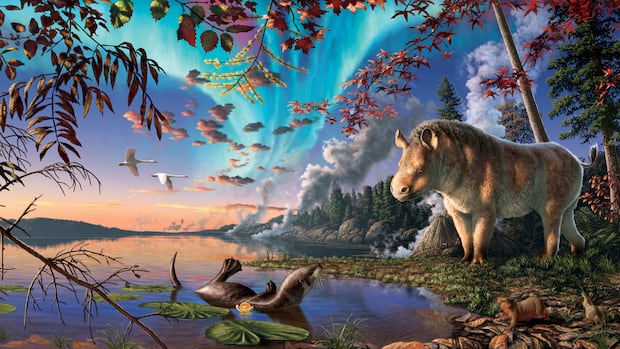Millions of years ago, a pony-sized, hornless rhino wandered through the woods and munched on leaves in what is now northern Nunavut, making it the northern-most rhino ever found.A new study published on Tuesday identifies it as a new species, and offers an intriguing explanation for how it got there.Epiatheracerium itjilik was about the size of a modern Indian rhinoceros and far smaller than an African rhino, standing about a metre at the shoulder, said Danielle Fraser, lead author of the new study published in the journal Nature Ecology and Evolution.Researchers found more than 70 per cent of the animal’s skeleton in the Haughton Crater on Devon Island, about 1,000 kilometres north of the Arctic Circle — beating the record for the northern-most rhino previously set by a Yukon specimen. Overhead view of the fossil of Epiatheracerium itjilik. About 75 per cent of the animal’s bones were recovered, including diagnostic parts such as the teeth, mandibles and pieces of the cranium. (Pierre Poirier/Canadian Museum of Nature)From its skull, teeth and other bones, they were able to learn a lot about it. The wear on its teeth showed it was in early to middle adulthood.Natalia Rybczynski, a paleobiologist at the Museum of Nature and Carleton University who co-authored the new study, said the researchers believe the rhino was female. That’s due to the small size of some lower teeth that tend to be much larger in male rhinos. In an artist’s reconstruction, a furry rhino with wide-set nostrils and no horn stands at the edge of a lake near lilies, swans and an otter-like creature. In the background, there is a forest of pine and spruce, alongside maple, birch and alder in fall colours, and northern lights fan across the twilit sky. “I wanted the artist to make the rhino look like a pony in winter,” said Fraser, head of paleobiology at the Canadian Museum of Nature in Ottawa.While the climate was similar to that of southern Ontario today, winters would have been snowy, and Fraser reasoned that the animal would have had to stay warm during long dark winters in its polar home.Natalia Rybczynski, right, and Jarloo Kiguktak examine bones collected during an expedition to the Haughton Crater in 2008. Kiguktak, a local Inuit elder, helped name the new rhino. (Martin Lipman/Canadian Museum of Nature)In fact, its species name is the Inuktitut word for “frosty” or “frost” and was chosen by Jarloo Kigutak, an Inuit elder from Grise Fiord who worked with some of the paleontologists on fossil collecting trips on Devon Island and Ellesmere Island.Fraser said the new species walked on four toes instead of the three that most rhinos used: “It’s a little bit of a weirdo in that sense.”Interestingly, the fact that it didn’t have a horn isn’t unusual — most fossil rhinos were hornless, despite the “horned nose” name that comes from their modern descendants.Overall, though, the new species is quite different from the dozens of fossil rhino species that roamed North America. Instead, it has been added to a genus of similar species found in Europe, Epiatheracerium.That led to questions about how it ended up on Devon Island. Previous studies suggested there was a land bridge between Europe and North America — but it broke up about 33 million years before E. itjilik lived. From left, study co-authors Natalia Rybczynski, Danielle Fraser and Marisa Gilbert, holding rhino jaw, examine the bones of Epiaceratherium itjilik at the Canadian Museum of Nature in Ottawa. (Pierre Poirier/Canadian Museum of Nature)The researchers propose that the discovery of this rhino provides evidence that some animals could still cross over during the Early Miocene, despite there being water between islands at that time.”At different periods in time… there may have actually been some ice there in winter that allowed them to cross,” Fraser said. A 40-year waitWhile E. itijilik has only just become a new species, its first bones were discovered four decades ago by Mary Dawson, a paleontologist and curator at the Carnegie Museum of Natural History, who co-authors the new study posthumously, having died in 2020.Mary Dawson is seen searching for fossils at the Haughton Crater site in 2007. Dawson collected many of the bones of E. itjilik at the site in the 1980s. (Martin Lipman/Canadian Museum of Nature)The lake where E. itijilik once drank was in the Haughton Crater, a huge pit created by an asteroid impact in Devon Island. The artist’s impression of the rhino includes steam in the background from hydrothermal vents thought to have opened up due to the impact.The lake has long since dried up, leaving behind a polar desert that has been a rich source of fossil fragments, says Rybczynski. The fossils found there include lots of fish, swans, ducks, an otter-like ancestor of seals, “tonnes of” rabbits and a shrew — many of which appear in the artist’s reconstruction. It was a time when many kinds of horses, camels, rhinos and large predators such as sabre-toothed cats roamed North America — although so far, the rhino is the only large animal found at Haughton Crater. The Arctic freeze-thaw cycles cause the ground at the site to turn over frequently, surfacing, burying and scattering fragments of bone over wide areas. Paleontologists brush them out from the dusty soil, then bag and bring them back to the museum. But putting them back together can be a long, challenging process. Rybczynski said when the bones are laid out, “on the side we have a table of scraps” that the researchers hope to identify and place someday.When Dawson found the first bones of the rhino in 1986, she knew right away that it was a rhino, as rhinos have distinctive bands on their teeth, Fraser said. After returning to the Carnegie Museum, Dawson showed the bones to some fossil rhino experts. One was Donald Prothero, professor of geosciences at California State Polytechnic University, who has since written a book on fossil rhinos.He noted that the animal’s teeth and four toes resembled those found in some very ancient rhinos, but none as young as 23 million years ago. “I said, ‘Well, this is a very strange animal, good luck,'” Prothero recalled.He suggests that’s one reason it took so long to study thoroughly. Natalia Rybczyski and Mary Dawson sift for fossils during a 2007 expedition at the Haughton Crater on Devon Island, Nunavut. (Martin Lipman/Canadian Museum of Nature)A team including Dawson and Rybczynski returned to the fossil site multiple times in the late 2000s, and eventually managed to find about 70 per cent of the skeleton.Jaelyn Eberle, a Canadian paleontologist at the University of Colorado Boulder who studies Arctic mammal fossils, said it’s very unusual to find such a complete fossil skeleton, especially in the Arctic. Most of the time, you only find “little pieces, fragments, maybe part of a jaw, maybe a single tooth.” She said given how much they had of the animal, she feels confident in the results. Both she and Prothero said they were intrigued by the study’s suggestion that animals used a land bridge between Europe and Asia for much longer than thought.”That’s pretty interesting and pretty exciting,” Eberle said, adding that it makes her want to look for more evidence of animals crossing in that region.Like Prothero, she and other fossil mammals had long known about this rhino fossil and are excited to find out more. “We’ve been waiting for it.”
Wednesday, 17 Dec 2025
Canada – The Illusion
Search
Have an existing account?
Sign In
© 2022 Foxiz News Network. Ruby Design Company. All Rights Reserved.
You May also Like
- More News:
- history
- Standing Bear Network
- John Gonzalez
- ᐊᔭᐦᑊ ayahp — It happened
- Creation
- Beneath the Water
- Olympic gold medal
- Jim Thorpe
- type O blood
- the bringer of life
- Raven
- Wás’agi
- NoiseCat
- 'Sugarcane'
- The rivers still sing
- ᑲᓂᐸᐏᐟ ᒪᐢᑿ
- ᐅᑳᐤ okâw — We remember
- ᐊᓂᓈᐯᐃᐧᐣ aninâpêwin — Truth
- This is what it means to be human.
- Nokoma











